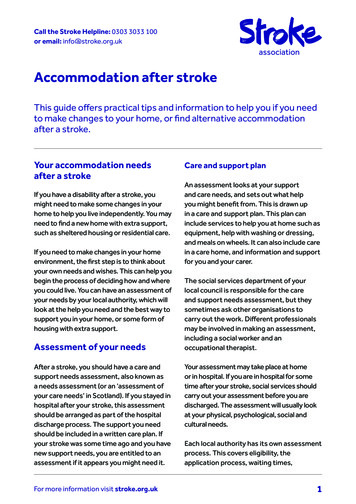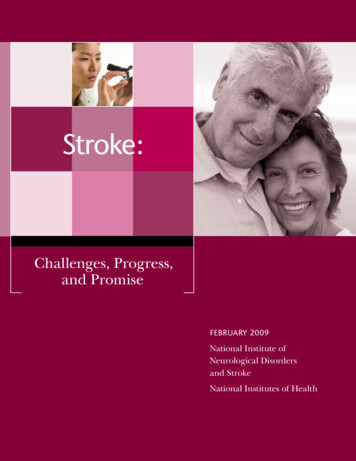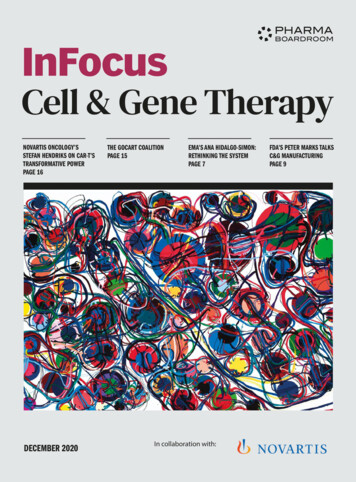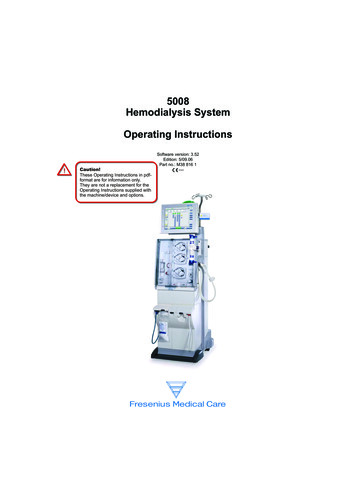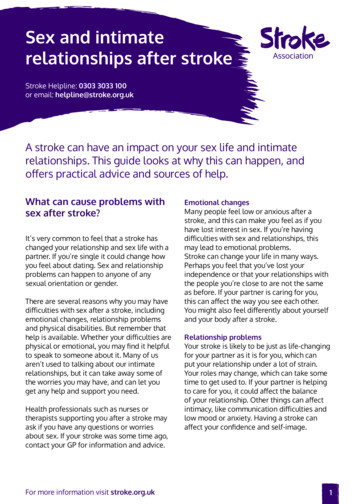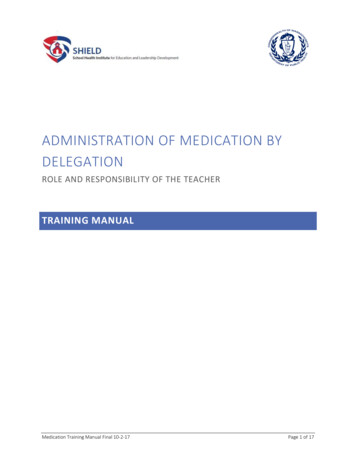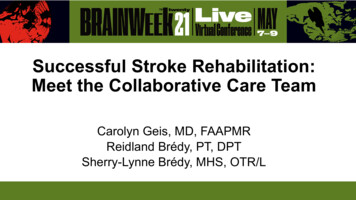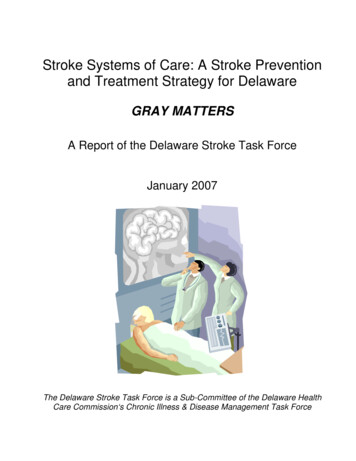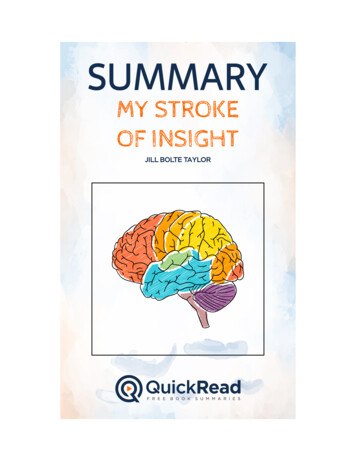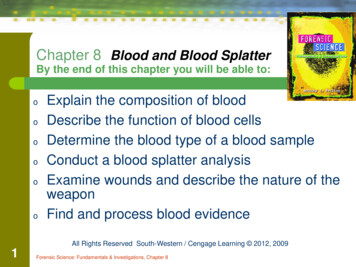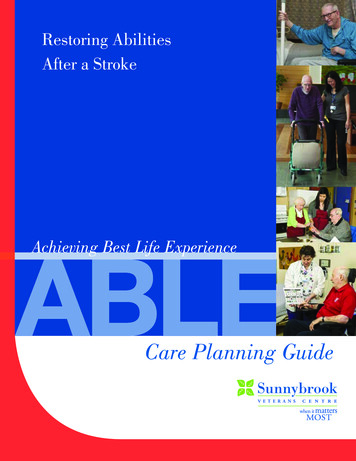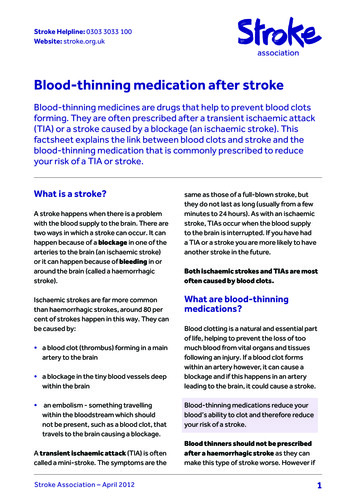
Transcription
Stroke Helpline: 0303 3033 100Website: stroke.org.ukBlood-thinning medication after strokeBlood-thinning medicines are drugs that help to prevent blood clotsforming. They are often prescribed after a transient ischaemic attack(TIA) or a stroke caused by a blockage (an ischaemic stroke). Thisfactsheet explains the link between blood clots and stroke and theblood-thinning medication that is commonly prescribed to reduceyour risk of a TIA or stroke.What is a stroke?A stroke happens when there is a problemwith the blood supply to the brain. There aretwo ways in which a stroke can occur. It canhappen because of a blockage in one of thearteries to the brain (an ischaemic stroke)or it can happen because of bleeding in oraround the brain (called a haemorrhagicstroke).Ischaemic strokes are far more commonthan haemorrhagic strokes, around 80 percent of strokes happen in this way. They canbe caused by: a blood clot (thrombus) forming in a mainartery to the brain a blockage in the tiny blood vessels deepwithin the brain an embolism - something travellingwithin the bloodstream which shouldnot be present, such as a blood clot, thattravels to the brain causing a blockage.A transient ischaemic attack (TIA) is oftencalled a mini-stroke. The symptoms are theStroke Association – April 2012same as those of a full-blown stroke, butthey do not last as long (usually from a fewminutes to 24 hours). As with an ischaemicstroke, TIAs occur when the blood supplyto the brain is interrupted. If you have hada TIA or a stroke you are more likely to haveanother stroke in the future.Both ischaemic strokes and TIAs are mostoften caused by blood clots.What are blood-thinningmedications?Blood clotting is a natural and essential partof life, helping to prevent the loss of toomuch blood from vital organs and tissuesfollowing an injury. If a blood clot formswithin an artery however, it can cause ablockage and if this happens in an arteryleading to the brain, it could cause a stroke.Blood-thinning medications reduce yourblood’s ability to clot and therefore reduceyour risk of a stroke.Blood thinners should not be prescribedafter a haemorrhagic stroke as they canmake this type of stroke worse. However if1
Blood-thinning medication after strokeyou have had a haemorrhage but also havea very high risk of ischaemic stroke, yourconsultant may decide that the benefit oftaking blood-thinning medication wouldoutweigh the risk.There are two types of blood thinners,antiplatelets and anticoagulants, andthey work at different stages of the bloodclotting process.AntiplateletsThese drugs work by preventing theplatelets in the blood from sticking together.Commonly prescribed antiplatelets are: aspirin dipyridamole clopidogrel.AnticoagulantsAnticoagulants are blood thinners that workat a different stage of the blood-clottingprocess by preventing the production ofa protein called fibrin. Anticoagulants alsomake existing blood clots more stableand less likely to break off and travel in thebloodstream. Examples of anticoagulantsare: warfarin dabigatran etexilate rivaroxaban.Which medication will I have?tests show that you could benefit fromaspirin, you will be started on a daily dose of300mg (milligrams) immediately.If you had a stroke and a brain scan confirmsit is ischaemic, you may be given 300mg ofaspirin initially, which you will need to takefor two weeks.Long-term treatmentIn the longer term you will usually beprescribed a different blood-thinningmedication to reduce your risk of stroke.You will usually have to continue taking thismedication forever.Recent guidelines from the National Institutefor Health and Clinical Excellence (NICE)outline which medication you should betaking. These guidelines apply to the wholeof the UK.If you have had a TIA, you will usually begiven: dipyridamole and aspirin, or dipyridamole alone if you cannot takeaspirin.If you have had a stroke, you will usually begiven: clopidogrel, or dipyridamole and aspirin if you are unableto take clopidogrel, or dipyridamole alone if you cannot takeclopidogrel or aspirin.Initial treatmentAfter a TIA your risk of stroke is highestwithin the first 7 to 14 days. If you have asuspected TIA, you should be diagnosed asquickly as possible. If a brain scan or other2If you have atrial fibrillation (a type ofirregular heartbeat) and have had a strokeor TIA you will usually be prescribed ananticoagulant medication instead.Stroke Association – April 2012
Blood-thinning medication after strokeTypes of blood-thinningmedicationThis section contains information about thefollowing medications: clopidogreldipyridamoleaspirinwarfarindabigatran etexilaterivaroxaban.name Persantin. It is an antiplateletmedication often prescribed together withaspirin. If this is the case you will usually beprescribed a total daily dose between 50300mg of aspirin and 400mg dipyridamole.A drug which combines both aspirin anddipyridamole in one tablet is available andcalled Asasantin.If you are taking dipyridamole alone, forexample if you cannot take aspirin, it isusually given as a 200mg tablet taken twicea day.ClopidogrelClopidogrel (brand name Plavix) is anantiplatelet that works by blocking achemical called ADP, which acts on theplatelets in the blood.Usually the dose prescribed after stroke is75mg. It can be taken with or without food,and you should take this medication at thesame time each day.Clopidogrel is not suitable for everyone. Itis not recommended for women who arepregnant or breastfeeding because of a lackof research in this area. It also interactswith other medications such as aspirin,dipyridamole, warfarin and proton pumpinhibitors (see section on aspirin).It is also not recommended if you havesevere liver impairment or a bleedingdisorder.The main side effect of clopidogrel isunwanted bleeding. More rarely, nausea,vomiting, headache, dizziness, constipation,itching and sore throat can occur.There are many medical conditions thatmight mean this drug is unsuitable foryou. These include severe coronary arterydisease or if you have recently had a heartattack. It is important to make sure yourdoctor is aware of your full medical historybefore starting this treatment.It is not recommended during pregnancybecause it can lead to complications. It canalso react with anticoagulant, antiplateletand blood pressure medicines to name just afew (check the patient information leaflet orspeak to your doctor for more information).There are some very common side effectsof dipyridamole such as an upset stomach,nausea, dizziness, indigestion and headacheswhich can affect as many as one in ten people.Headaches can sometimes be improved byhaving the dose of dipyridamole reduced for aperiod of time (e.g. a month), after which it isthen raised back to the full dose.DipyridamoleContact your doctor at once if you have anallergic reaction such as runny nose, itchyskin, swelling in the face or severe breathingdifficulties.Dipyridamole is also known by the brandThere are other complications that are lessStroke Association – April 20123
Blood-thinning medication after strokecommon like bleeding, rashes, muscle painand fainting.AspirinAspirin is a painkiller which belongs to a classof medicines called NSAIDs (non-steroidalanti inflammatory drugs). It is also anantiplatelet.If you are prescribed aspirin to reduce yourrisk of stroke, you may be given between75mg and 300mg depending on yourindividual circumstances. lansoprazoleomeprazolepantoprazolerabeprazole.If you develop indigestion whilst takingaspirin you may be prescribed a PPI alongwith two antibiotics: this is known as tripletherapy. Relief from symptoms is usuallyfelt within two hours and the course lastsfor one to two weeks. Unfortunately, PPIscan have side effects, too, which can includeconstipation and diarrhoea.WarfarinIt is advisable to take aspirin with food toreduce any stomach irritation which is itsmain side effect.Aspirin is not suitable for people whohave an allergy to aspirin or other similarmedications, asthma, kidney disease,or bleeding disorders. It is not usuallyprescribed during pregnancy.The main side effect of aspirin is irritationof, and/or bleeding from, the lining of thestomach. For this reason, aspirin is notsuitable for people who have peptic ulcers.Other side effects can include indigestion,nausea and vomiting.Some people develop indigestion whentaking aspirin because the protective liningof the stomach is weakened and stomachacid begins to damage it. This can lead toabdominal pain, vomiting and changes toyour appetite. A proton pump inhibitor(PPI) is an anti-ulcer drug. It is usually givento people who have previously taken aspirinand developed indigestion. The following is alist of PPIs: 4esomeprazoleWarfarin is commonly prescribed toreduce the risk of stroke if you have atrialfibrillation (a type of irregular heartbeat),rheumatic heart disease, or after you havehad artificial heart valves inserted.It works by changing the way your liveruses vitamin K. Vitamin K is an importantvitamin in the blood-clotting process. Theless vitamin K you have the longer it takesfor the blood to clot. Our livers removewarfarin from our bodies but because we areall different, the dose needed varies fromperson to person.Warfarin tablets should be taken at thesame time each day and are available indifferent strengths, colour-coded as follows: 1mg - brown tablets3mg - blue tablets5mg - pink tabletsIf you are taking warfarin, you will need tohave blood tests to make sure that yourblood does not become too thin as it couldincrease your risk of bleeding. The blood testcompares how quickly your blood clots at aStroke Association – April 2012
Blood-thinning medication after strokeparticular stage in the process and comparesit to the International Normalised Ratio(INR). INR is expressed as a value. A normalINR value for blood that is not anticoagulatedis 1. Depending on your health condition,different INR levels will be sought. Forexample, if you have atrial fibrillation yourblood should be two to three times thinner,so an INR value of 2 to 3 is aimed for.When you first start taking warfarin you mayneed to attend an anticoagulation clinicweekly as they adjust the dose to suit you.When it is stable, you will probably need toattend every six to eight weeks for bloodtests.It is also possible to monitor your own INRwith a machine you can keep at home. YourGP will provide you with test strips to use init, though you will have to buy the machineyourself. Their cost varies from 400 to 800. Research shows that self monitoringmay be more beneficial than having your INRtested at a clinic. However it is not suitablefor everyone; about half of all people takingwarfarin are able to do these blood tests athome. You will need some initial training inhow to test your own INR levels and arrangewith your clinic what to do if your INR isoutside the recommended range for you,and how you can contact them if needed.Warfarin also interacts with othermedicines which can increase its effect.This means that your INR level will increase.Some medicines that have this effect are: damoleNSAIDsstatinsulcer medicines.There are also medicines, including herbalremedies that reduce the effects of warfarin.Always check the medicines with yourGP and pharmacist and read the patientinformation leaflets.Minor side effects of this drug includerashes, nausea, vomiting and diarrhoea.The main side effect of warfarin is bleeding.Anyone experiencing bleeding shouldseek medical attention and have an urgentblood test.Warfarin and foodBecause warfarin affects vitamin K, whichis contained in some foods, you need to becareful what you eat.When you are first prescribed warfarin youshould be given a pack from your GP orhospital which contains a credit-card sizedalert card, a yellow patient informationbooklet titled ‘Oral Anticoagulant Therapy’,and a record card.Foods that have high levels of vitaminK include pine nuts, fruit such as kiwi,blueberries and blackberries, mature cheese,blue cheese, egg yolks, chick peas, liver, oliveoil, cereals containing wheat bran and oats,and green leafy vegetables .Warfarin should not be taken if you havesevere hypertension, peptic ulcers orbacterial endocarditis. It should also beavoided if you are pregnant.These foods are healthy for us and canhelp to reduce your risk of stroke and heartattack. Your warfarin levels are usuallyadjusted to balance out any high levels ofStroke Association – April 20125
Blood-thinning medication after strokevitamin K from your diet.accompanied by dizziness or weakness.Cranberry juice is an exception andyou should not drink it if you are takingwarfarin.RivaroxabanIf you wish to change your diet suddenly,you should consult a doctor and youranticoagulation clinic so that the effects ofwarfarin can be monitored more closely andchanged if necessary.It is also advisable to keep alcohol to aminimum whilst taking warfarin as this willincrease your INR value and the risk of havinga serious bleed. Binge drinking is particularlydangerous and should be avoided.Rivaroxaban (also known by the brand nameXarelto) is also a new type of anticoagulant.It belongs to a group of medicines calledantithrombotic agents. It works by blockinga specific protein in the blood, Factor Xa,which plays a key role in the blood-clottingprocess.Rivaroxaban is usually prescribed at a doseof 20mg and must be taken with food. Ifyou have kidney problems, you will usuallybe given a reduced dose of 15mg. It is alsoadvisable to take it at the same time eachday.Dabigatran etexilateDabigatran etexilate (brand name Pradaxa)is a newer anticoagulant. It belongs to agroup of medicines called direct thrombininhibitors. Thrombin is a clotting agent inour blood and dabigatran etexilate works byattaching itself to the thrombin so it is lesslikely to form a clot. It is usually prescribed ata dose of 150mg or 110mg, and then twicedaily taken with or without food.It is not usually prescribed if you arepregnant or breastfeeding. Dabigatranetexilate can also interact with othermedication, for example aspirin, clopidogrel,heparin, rivaroxaban and verapamil. It alsointeracts with the herbal remedy St John’sWort.Side effects of dabigatran etexilateinclude bleeding, anaemia, diarrhoea,indigestion, nausea and stomach pain. Youshould seek medical attention if you havesevere or uncontrollable bleeding, unusualbruising, unexpected pain, or headaches6Rivaroxaban is not usually recommended tobe used in pregnancy or while breast feeding.It interacts with other medications suchas aspirin, clopidogrel and warfarin and theherbal remedy St John’s Wort.Side effects of rivaroxaban include bleeding,constipation, diarrhoea, dizziness andfainting. You should seek medical attentionif you notice any of the following symptoms:unexplained dizziness or weakness, swellingand discomfort, sudden, severe headache,unusual bruising, nosebleeds, bleeding gumsor cuts that take a long time to heal.Which anticoagulant medicationshould I take?The most commonly prescribedanticoagulant is warfarin, but it does requirecareful monitoring. The advantages of thenewer medications (dabigatran etexilateand rivaroxaban) are that their effect onyour blood is more stable and they are notaffected by any foods that you eat, so theyStroke Association – April 2012
Blood-thinning medication after strokedo not need to be monitored as carefully aswarfarin. Your doctor will decide which typeof anticoagulant medication is most suitablefor you.Other new anticoagulantsThere is currently more research underwayon other new anticoagulants for reducing therisk of stroke in people with atrial fibrillation.Of these, apixaban is in the most advancedstages of development, but additional drugsare likely to be available in time.What else do I need to know?Please note that we have not provided anexhaustive list of side effects and druginteractions. Always refer to the patientinformation leaflet that comes with yourmedication for a full list.Tell your doctor about any new medicationyou are taking. Your pharmacist may alsobe able to give you advice about yourmedications.When starting an anticoagulant medicationyou will be given a patient alert card whichyou should carry with you at all times. Tellyour dentist you are taking an anticoagulantmedication before you have any treatment.Never stop taking your medication if you feelunwell. Always contact your GP for advice– stopping medication suddenly can bedangerous. In a medical emergency, alwayscall 999.Useful organisationsAll organisations listed are UK wide unlessotherwise stated.Stroke AssociationStroke Helpline: 0303 3033 100Website: stroke.org.ukEmail: info@stroke.org.ukContact us for information about stroke,emotional support and details of localservices and support groups.Anticoagulation EuropeTel: 020 8289 6875Website: www.anticoagulationeurope.orgSupport and information for anyone takinganticoagulant medication.Arrhythmia AllianceTel: 01789 450 787 (24 hour)Website: www.heartrhythmcharity.org.ukSupports people with all types of heartarrhythmias.Atrial Fibrillation Association (AFA)Tel: 01789 451837Website: www.atrialfibrillation.org.ukSupports people with atrial fibrillationoffering a range of leaflets on treatmentsand medication plus details of specialists.British Heart Foundation (BHF)Tel: 0300 330 3311Website: www.bhf.org.ukProvides information and support on heartissues, including atrial fibrillation, and someblood-thinning medications.NHS Choices (England and Wales)Website: www.nhs.ukFor general information on all aspectsof health including stroke, as well asinformation on the different types of bloodthinning medicines.Stroke Association – April 20127
Blood-thinning medication after strokeNHS ScotlandNHS Inform Helpline: 0800 22 44 88Website: www.nhsinform.co.ukInformation on health conditions,treatments and health services in Scotland.Glossary of termsNorthern Ireland (NI) Direct Governmentservices website: /healthand-well-being.htmInformation on health and well-being.Antiplatelet a type of blood thinnerDisclaimer: The Stroke Association providesthe details of other organisations forinformation only. Inclusion in this factsheetdoes not constitute a recommendation orendorsement.Anticoagulant a type of blood thinnerusually prescribed if you have atrialfibrillation, a type of irregular heartbeatAtrial fibrillation type of irregular heart beatEmbolism something travelling within thebloodstream which should not be present,such as a blood clot, air bubble or fat globuleINR international normalised ratioIschaemic stroke interruption to bloodflow caused by a blockageNSAIDs anti inflammatory drugsPlatelets small blood cells that sticktogether to form a blood clotPPI proton pump inhibitor (an anti-ulcer drug)Thrombus blood clotTIA transient ischaemic attackProduced by the Stroke Association’s Information Service.For sources used, visit stroke.org.uk Stroke AssociationFactsheet 11, version 01 published April 2012,(next revision due September 2014).Item code: A01F11The Stroke Association is a charity. We rely on your support.Text STROKE 5 to 70300 to donate 5. 100% of your donation goes to the StrokeAssociation. Find out how your support helps at stroke.org.uk/savelivesThe Stroke Association is a company limited by guarantee, registered in England and Wales (No 61274).Registered office: Stroke Association House, 240 City Road, London EC1V 2PR. Registered as a charity in England and Wales(No 211015) and in Scotland (SC037789). Also registered in Northern Ireland (XT33805), Isle of Man (No 945) and Jersey (NPO 369).8Stroke Association – April 2012
Blood-thinning medicines are drugs that help to prevent blood clots forming. They are often prescribed after a transient ischaemic attack (TIA) or a stroke caused by a blockage (an ischaemic stroke). This factsheet explains the link between blood clots and stroke and the blood-thinning medication that is commonly prescribed to reduce
